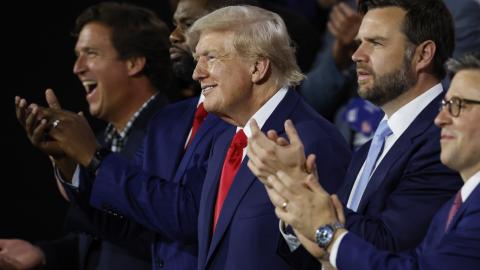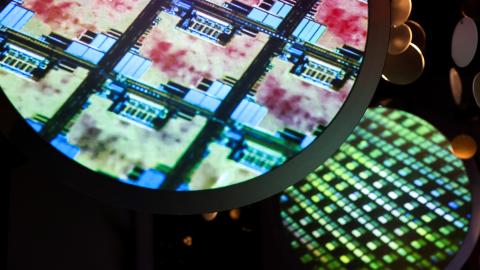Its clearly a budget. Its got a lot of numbers in it, George W. Bush is alleged to have told a reporter during his run for the presidency some four years ago. After examining the budget that the President submitted to Congress last week most of Washington is saying, Its clearly a budget. Its got a lot of lies in it. Wall Street may be talking about the increasingly glowing profits reports that are now a daily occurrence, or the rise in consumer confidence to its highest level since July 2002, orbest of allthe revival of fee-generating merger activity. But in Washington, its all about the $2.4 trillion budget that the President has put before Congress.
With reason. A budget is, after all, more than a lot of numbers. It is a statement of the spending priorities of the administration in power, and of its attitude toward the trade-off between taxing and borrowing as the means of funding those priorities.
The President has been absolutely clear on both scores. His spending priorities are homeland security and the War on Terrorism. And he plans to pay for those priorities by issuing U.S. government IOUs. Many past presidents have refused to choose between guns and butter, with dire consequences for the economy. George W. Bush has decided to have both guns and butter, and, in addition, tax cuts and a trip to Mars that his father once estimated would eventually cost about $400 billion. All in all, the President is projecting a deficit of $521 billion, up from $375 billion last year. And that doesnt include some $50 billion that the administration will be requesting for Iraq later this year.
The good news is that forecasts of budget deficits are notoriously inaccurate. But, the errors in this forecast are likely to be in one direction. Consider just one item, the new prescription drug program for the elderly. Just a few months ago the cost was estimated to be $400 billion over ten years; now the estimate is $540 billion. And no serious analyst believes that will be the last increase in the projected cost of acceding to the demands of the increasingly political power of the grey lobby.
Throw in some other Bush initiativesa $72 billion energy bill remains on the Presidents wish listand you have a riot of spending that calls into question the Presidents projection of a gradually shrinking deficit. It is obviously easier to turn on the spending spigot, and to cut taxes, than to turn off the spigot and raise taxes. Not for the White House fans of John Maynard Keynes his warning, There is a good deal of advantage in retarding expenditure by such [government] bodies when other sources of demand are strong. . . .
Nor does anyone believe that the President will persuade Congress to go along with the virtual freeze he wants to impose on spending on the environment, the highways and mass transit projects on which Congress proposes to spend $375 billion over the next six years, and a gaggle of other domestic programs. But in this election year he is more likely to be able to persuade Congress to make permanent the tax cuts that he quite properly pushed through to reduce the length and severity of the recent economic slowdown.
The reaction of Washingtons Democrats is predictable. They want to repeal some of the tax cuts so that they can expand spending on various entitlement programs. Not for them fiscal austerity. Republicans, meanwhile, are divided between the White House crowd that cant see beyond the November elections and therefore couldnt care less about the deficit, and the bulk of the party that worries that so much red ink will alienate core voters who favor smaller government and balanced budgets.
Indeed, even the Presidents budgeteers concede in the fine print that long-run budget projections show clearly that the budget is on an unsustainable path.
Then there are the more or less nonpartisan analysts who populate the think tanks that are a short walk from the White House. They naturally take a longer, and therefore gloomier view of the state of Americas finances. Scholars at the respected liberal-leaning Brookings Institution say that even if all federal spending on education, housing, job training, and similar programs is eliminated, the budget would still be spilling red ink a decade from now.
Worse still, in not too many years the knees, hips, hearts, and digestive tracts of the Baby Boomer generation will be in need of more expensive care and treatment, driving up health care costs and, soon thereafter, the cost of pensions. The Presidents budget document shows that even under the most optimistic assumptions about economic growth, and Bushs assumptions about spending, after 2009 the deficit widens to a mind-boggling 10 percent of GDP, two-and-one-half times the level it averaged during the administrations of Ronald Regan and the elder Bush.
Problems that politicians refuse to confront end up being handled by markets. As the foreigners who have been funding the deficit become more and more reluctant to add to the pile of U.S. IOUs they have accumulated, they will demand higher interest rates. So will domestic investors, who know that fiscal promiscuity means higher inflation, as the government runs its printing presses overtime. So interest rates will rise.
But probably not enough to stem the decline in the dollar, needed to make imports more costly, and exports more competitive. So the dollar will fall.
Result: higher inflation, higher interest rates, a cheaper dollar. But by then Bush expects to be safely back in the White House. His supporters are whispering that he will then clean up the fiscal mess, rather than leave it as his legacy. Doubters outnumber supporters.
This article appeared in Londons Sunday Times on February 8, 2004.



















